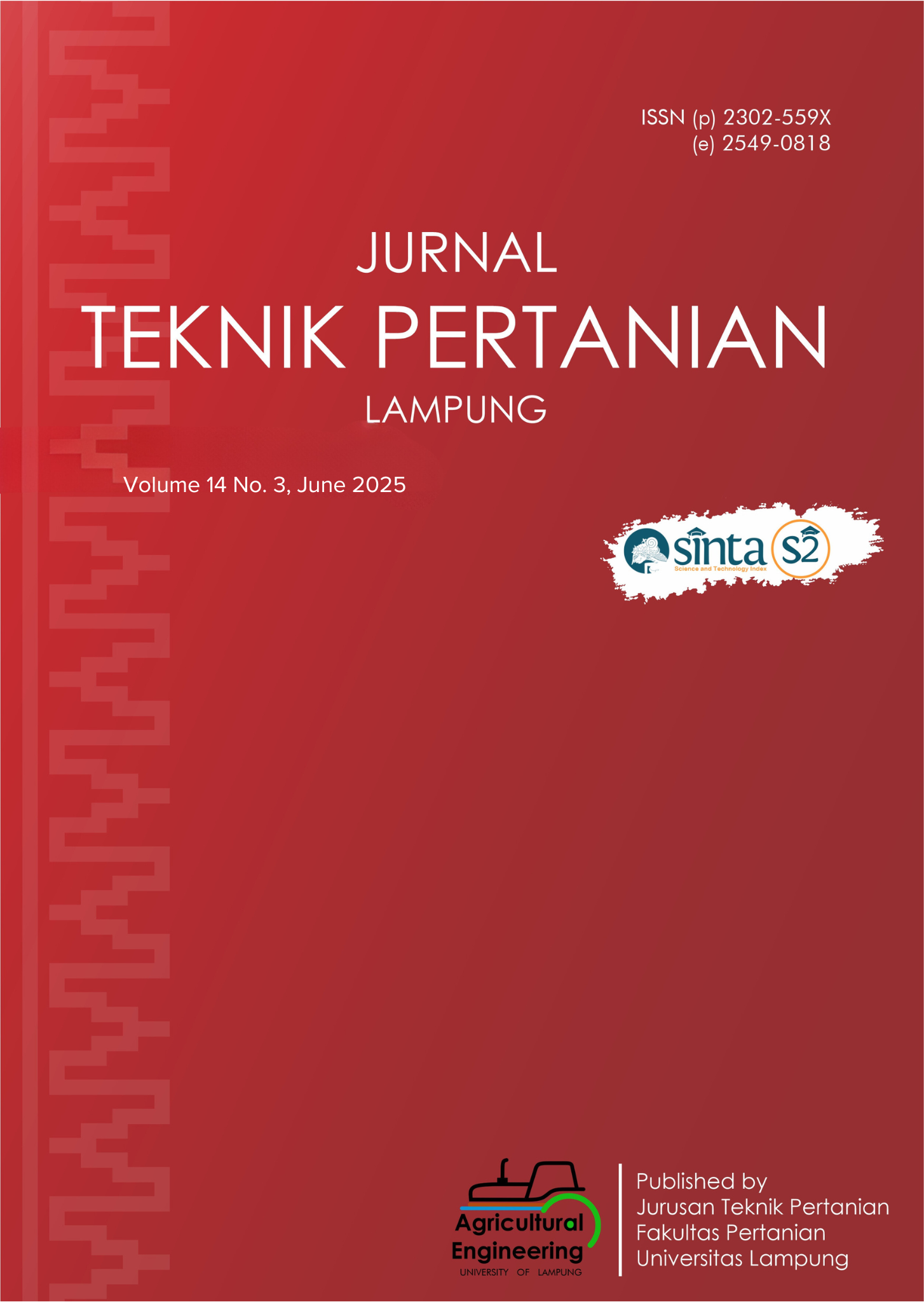Effectiveness of Endophytic Bacteria Rhizophora sp. from Mangrove Plants to Control Root-Knot Nematodes (Meloidogyne spp.).
DOI:
https://doi.org/10.23960/jtep-l.v14i3.1110-1117 Abstract View: 92
Abstract View: 92
Abstract
Meloidogyne spp. is a root-knot nematode that can cause damage to plants up to 68%. The common control is the use of pesticides, but in the long term, it can damage the soil, so it is necessary to use biological agents that can control Meloidogyne spp. without causing environmental damage. The purpose of this study was to determine the ability of endophytic bacteria to control root-knot nematodes Meloidogyne spp.. The method used in this study was the exploration of endophytic bacteria from the Wonorejo mangrove ecotourism area, Surabaya using purposive sampling method. The five best endophytic bacteria were tested further with antagonistic tests. This test was carried out in vitro using 3 concentrations, namely 106, 108, and 1010 CFU/ml with 3 repetitions. The obtained results were tested using probit analysis to obtain the LC50 values. It was found that LC50 values for the most effective concentration to kill 50% of the Meloidogyne sp population is 109 and 1010 CFU/ml. It was also revealed that the isolate that is most capable of controlling Meloidogyne spp. nematodes is isolate A43.
Keywords: Antagonist test, Endhopic bacteria, LC50, Mangrove, Meloidogyne spp.
Downloads
References
Gayathri, P., & Muralikrishnan, V. (2013). Isolation and characterization of endophytic actinomycetes from mangrove plant for antimicrobial activity. International Journal of Current Microbiology and Applied Sciences, 2(11), 78–89.
Harni, R. (2016). Prosfek pengembangan bakteri endofit sebagai agens hayati pengendalian nematoda. Perspektif, 15(1), 31-49.
Harni, R., Supramana, S., Sinaga, M.S., Giyanto, G., & Supriadi, S. (2020). Pengaruh filtrat bakteri endofit terhadap mortalitas, penetasan telur dan populasi nematoda peluka akar Pratylenchus brachyurus pada nilam. Jurnal Penelitian Tanaman Industri, 16(1), 43-47.
Huzni, M., Tri Rahardjo, B.T., & Tarno, H. (2015). Uji laboratorium ekstrak kirinyuh (Chromolaenaodorata: King & Robinson) sebagai nematisida nabati terhadap Meloidogyne spp. (Chitwood). Jurnal Hama Penyakit Tumbuhan, 3(1), 93–101. https://jurnalhpt.ub.ac.id/index.php/jhpt/article/view/170
Irawanto, R. (2020). Keanekaragaman vegetasi mangrove di Pesisir Kota Surabaya dan potensinya sebagai fitoremediator lingkungan. Prosiding Seminar Nasional Biologi, 6(1), 413–422.
Jelita, S.F., Setyowati, G.W., & Ferdinand, M. (2020). Uji toksisitas infusa acalypha simensis dengan metode brine shrimp lethality test (BSLT). Jurnal Farmaka, 18(1), 14–22.
Khotimah, N., Wijaya, I.N., & Sritamin, M. (2020). Perkembangan populasi nematoda puru akar (Meloidogyne spp.) dan tingkat kerusakan pada beberapa tanaman familia solanaceae. Jurnal Agroekoteknologi Tropika, 9(1), 23–31. https://ojs.unud.ac.id/index.php/jat/article/view/56747
Lyu, D., Zajonc, J., Pagé, A., Tanney, C.A.S., Shah, A., Monjezi, N., Msimbira, L.A., Antar, M., Nazari, M., Backer, R., & Smith, D.L. (2021). Plant holobiont theory: The phytomicrobiome plays a central role in evolution and success. Microorganisms, 9(4), 675. https://doi.org/10.3390/microorganisms9040675
Mahmudah, K.R. (2024). Estimasi parameter pada model seleksi sampel heckman dengan kovariat endogen menggunakan pendekatan kemungkinan maksimum informasi penuh. Jurnal Lebesgue : Jurnal Ilmiah Pendidikan Matematika dan Statistika, 5(1), 289–299. https://doi.org/10.46306/lb.v5i1.558
Mullo, I.A., Siahaan, P., & Wahyudi, L. (2022). Uji Patogenisitas jamur metarhizium rileyi (farlow) isolat tomohon terhadap larva ulat grayak Spodoptera frugiperda (lepidoptera: noctuidae). Jurnal Bios Logos, 12(1), 31-38.
Mustika, I. (2005). Konsepsi dan strategi pengendalian nematoda parasit tanaman perkebunan di Indonesia. Perspektif, 4(1), 20-32.
Oktafiyanto, M.F., Munif, A., & Mutaqin, K.H. (2018). Aktivitas antagonis bakteri endofit asal mangrove terhadap Ralstonia solanacearum dan Meloidogyne spp. Jurnal Fitopatologi Indonesia, 14(1), 23.
Poedjirahajoe, E., Marsono, D., & Wardhani, F.K. (2017). Penggunaan principal component analysis dalam distribusi spasial vegetasi mangrove di Pantai Utara Pemalang. Jurnal Ilmu Kehutanan, 11(1), 29-42. https://doi.org/10.22146/jik.24885
Pratiwi, R.S., Susanto, T.E., Wardani, K.A.Y., & Sutrisno, A. (2015). Enzim kitinase dan aplikasi di bidang industri : kajian pustaka. Jurnal Pangan dan Agroindustri, 3(3), 878–887.
Raihana, R., Fitriyanti, D., & Zairin, Z. (2018). Aplikasi perkembangan stadia hidup nematoda puru akar (Meloidogyne spp.) mulai dari fase telur sampai dewasa pada pertanaman tomat (Solanum lycopersicum L.) di Kota Banjarbaru. Agroekotek, 1(2), 25-35.
Ramadhanty, M.A., Lunggani, A.T., & Nurhayati. (2021). Isolasi bakteri endofit asal tumbuhan mangrove Avicennia marina dan kemampuannya sebagai antimikroba patogen Staphylococcus aureus dan Salmonella typhi secara in vitro. NICHE Journal of Tropical Biology, 4(1), 16–22. https://doi.org/10.14710/niche.4.1.16-22
Reed, C.J., Lewis, H., Trejo, E., Winston, V., & Evilia, C. (2013). Protein adaptations in archaeal extremophiles. 2013(1), 373275. https://doi.org/10.1155/2013/373275
Singh, A., & Zahra, K. (2017). Lc50 assessment of cypermethrin in heteropneustes fossilis : Probit analysis. International Journal of Fisheries and Aquatic Studies, 5(5), 126-130.
Subedi, S., Thapa, B., & Shrestha, J. (2020). Overview of root-knot nematode (Meloidogyne incognita) and control management. Journal of Agriculture and Natural Resources, 3(2), 21-31. https://doi.org/10.3126/janr.v3i2.32298
Tintori, S.C., Sloat, S.A., & Rockman, M.V. (2022). Rapid Isolation of Wild Nematodes by Baermann Funnel. Journal of Visualized Experiments, 179, e63287. https://doi.org/10.3791/63287
Yudantari, N., Sritamin, M., & Singarsa, I. (2015). Uji efektifitas berbagai konsentrasi ekstrak daun tanaman terhadap penekanan populasi nematoda puru akar (Meloidogyne spp.) dalam tanah, akar, dan produksi tanaman tomat (Lycopersicum esculentum Mill.). Jurnal Harian Regional, 4(3), 191-202.
Downloads
Published
How to Cite
Issue
Section
License
Authors who publish with this journal agree to the following terms:
Authors retain copyright and grant the journal right of first publication with the work simultaneously licensed under a Creative Commons Attribution-ShareAlike 4.0 International Lice that allows others to share the work with an acknowledgement of the work's authorship and initial publication in this journal.
Authors are able to enter into separate, additional contractual arrangements for the non-exclusive distribution of the journal's published version of the work (e.g., post it to an institutional repository or publish it in a book), with an acknowledgement of its initial publication in this journal.
Authors are permitted and encouraged to post their work online (e.g., in institutional repositories or on their website) prior to and during the submission process, as it can lead to productive exchanges, as well as earlier and greater citation of published work (See The Effect of Open Access).
Jurnal Teknik Pertanian Lampung

JTEPL is licensed under a Creative Commons Attribution-ShareAlike 4.0 International License.













